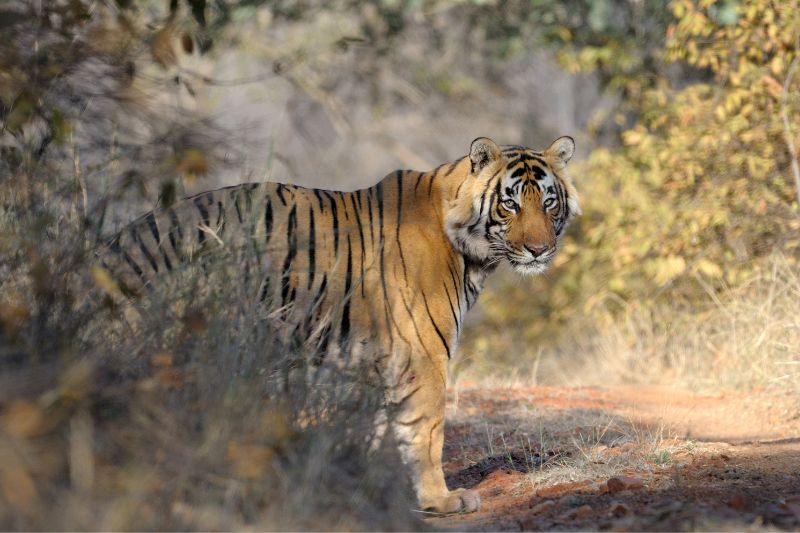Discover everything you need to know about seeing Indian animals in the wild in this Ranthambore travel guide.
Ranthambore National Park is close to the Golden Triangle tourist circuit in the north of the country. With 31 adult tigers and a few cubs calling it their home, Ranthambore is one of the best places in India to see tigers in the wild; Yet, you’d still be fortunate to catch a glimpse of one.
Much like everything in India, the park is absolutely beautiful. It’s set in an area of jungle and is easily identified by the ancient abandoned fort that overlooks the park, giving Ranthambore National Park its name. If you’ve ever seen or read Kipling’s The Jungle Book, you could imagine Mowgli running through the trees, King Louis sitting on his throne and Shere Khan silently stalking his prey. For us, it was the perfect setting for spotting tigers.
The Animals of Ranthambore
It goes without saying that Ranthambore National Park is one of the best places in India to see tigers in the wild. But there are also plenty of other Indian animals in Ranthambore that will make your safari an incredible wildlife experience.
Some of the most popular animals to see on safari in Ranthambore include:
- Sloth bear
- Indian leopard
- Sambar deer
- Chital deer
- Grey langur
- Macaque
- Indian flying fox
- Mugger crocodile
- Striped hyena
- Jackal
- Indian wild boar
Where to stay in Ranthambore
When choosing where to stay in Ranthambore, you’ll have plenty of choices to pick from. Whether you want a traditional safari tent in a camp, a budget-friendly dormitory in a hostel or a luxury hotel room with views of the park, you’ll find what you’re after.
I’ve selected my favourite places to stay in Ranthambore National Park below and split them by the price you can expect to pay each night.
On a Budget
Mid-Range
Luxury
Safari Companies in Ranthambore
When visiting Ranthambore with the intention of heading out on a safari, it’s important to pick a reputable company that takes conservation very seriously.
Many safari companies in Ranthambore will pile visitors on shared canters. These vehicles are noisy, large and can make it very difficult to get a good sighting of an animal with everyone on the canter trying to get the best view.
Instead, if your budget will allow, consider upgrading to a private jeep so you’ll be in more control of what you see, and you’ll have a much better chance of exclusive sightings. With fewer people and in smaller vehicles, animals are less likely to be disrupted, which can make for some relaxed photo opportunities.
Some of the best safari companies found in Ranthambore are listed below:
- Ranthambore safari Journeys
- Ranthambore Jungle Safaris
- Book Ranthambore Safari
How to get to Ranthambore
Ranthambore is ideally located near India’s Golden Triangle, a popular tourist route. This makes it really easy to reach by air, rail and road from Jaipur, New Delhi and Agra, as well as from other major cities in India.
Depending on where you stay, your accommodation may help you arrange a local taxi or transfer service from the nearest airport or train station. Alternatively, you will be able to hail a taxi or bus to reach your accommodation.
Getting to Ranthambore by air
The nearest airport to Ranthambore National Park is Sanganer Airport in Jaipur, which is well-served by both major airlines and budget carriers. As an international airport, you can reach Jaipur from Dubai, Bangkok and Muscat, as well as Delhi, Mumbai and Hyderabad.
Once you reach the airport, your accommodation may be able to organise a transfer, otherwise, you can take a taxi or bus to reach Ranthambore National Park.
Getting to Ranthambore by road
Buses and taxis may be a slightly more affordable option than flying, depending on the length and distance of your journey. Ranthambore National Park is connected by major roads to Jaipur, Delhi and Agra, all within a 6-hour drive.
Getting to Ranthambore by rail
The nearest major train station to Ranthambore is Sawai Madhopur Railway Station, which is approximately 10km outside of Ranthambore. Sawai Madhopur can be reached from all the main cities including Jaipur, Mumbai, New Delhi, Udaipur and Agra.
From there, ask your lodge to arrange a transfer for you, or simply take a taxi or local bus to reach your accommodation.
When to Visit Ranthambore
The best time to visit Ranthambore National Park is between the months of October and March. As this is the winter season in India, visitors (and animals!) will benefit from the slightly cooler temperatures and relatively dry conditions.
During this time, the animals may be easier to spot as they tend to congregate around water and can be seen warming up on the forest floor as they bask in the sunshine.
Between April and June, the national park remains open but the temperatures can often rise to 35c. As a result, the wildlife will look for shade and shelter in areas that visitors can’t reach.
Do note that the main areas of the national park are closed during the monsoon season from July to September.

